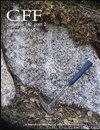瑞典Bergslagen Svärdsjö Zn-Pb-Cu矿床热液蚀变、岩石地球化学标志单元及成矿方向
IF 1.2
4区 地球科学
Q2 GEOLOGY
引用次数: 1
摘要
本文章由计算机程序翻译,如有差异,请以英文原文为准。
Hydrothermal alteration, lithogeochemical marker units and vectors towards mineralisation at the Svärdsjö Zn-Pb-Cu deposit, Bergslagen, Sweden
ABSTRACT The Svärdsjö Zn-Pb-Cu deposit is situated in the heavily mineralised Bergslagen lithotectonic unit of the Fennoscandian shield, south-central Sweden. Intense hydrothermal alteration followed by a strong overprint by deformation and metamorphism during the Svecokarelian orogeny complicate interpretation of the local geology. Integration of whole-rock lithogeochemical and petrographic methods has allowed the mainly dacitic volcanic host succession and effects of ore-related hydrothermal alteration to be characterised. Mineralisation is hosted by 2–15 m thick, commonly skarn-altered dolomitic marble interbeds. Zones of strong–intense hydrothermal chlorite-sericite alteration envelop the marble units, recording mass gains of Fe and Mg, as well as Na depletion. Minerals such as cordierite, anthophyllite and sillimanite formed in these rocks during regional metamorphism. Mineralisation via sub-seafloor replacement is suggested for the deposit based on alteration zoning and the irregular, stratabound, marble-hosted style of sulphide lenses. It is inferred that mineralisation formed via neutralisation of hot, acidic metalliferous fluids. Geochemically and lithologically distinct units adjacent to the mineralised zones can serve as marker units to aid further exploration in the area. Mass change calculations reveal that Fe and Mg enrichment, as well as Na depletion exhibit detectable changes extending up to 100 m from the mineralised lenses, providing exploration vectors.
求助全文
通过发布文献求助,成功后即可免费获取论文全文。
去求助
来源期刊

Gff
地学-地质学
CiteScore
2.80
自引率
10.00%
发文量
11
审稿时长
>12 weeks
期刊介绍:
GFF is the journal of the Geological Society of Sweden. It is an international scientific journal that publishes papers in English covering the whole field of geology and palaeontology, i.e. petrology, mineralogy, stratigraphy, systematic palaeontology, palaeogeography, historical geology and Quaternary geology. Systematic descriptions of fossils, minerals and rocks are an important part of GFF''s publishing record. Papers on regional or local geology should deal with Balto-Scandian or Northern European geology, or with geologically related areas. Papers on geophysics, geochemistry, biogeochemistry, climatology and hydrology should have a geological context. Descriptions of new methods (analytical, instrumental or numerical), should be relevant to the broad scope of the journal. Review articles are welcome, and may be solicited occasionally. Thematic issues are also possible.
 求助内容:
求助内容: 应助结果提醒方式:
应助结果提醒方式:


